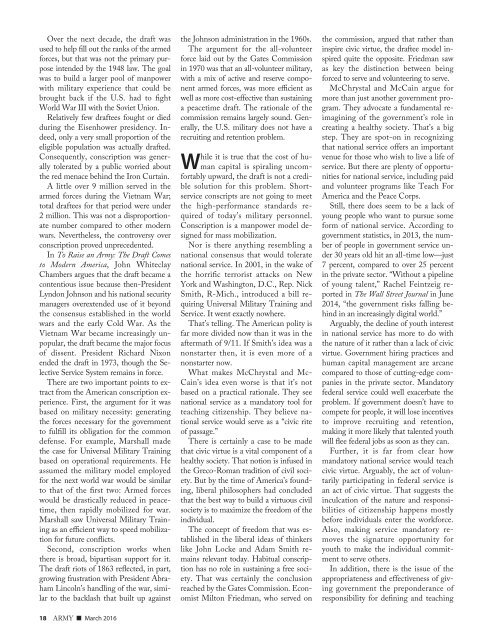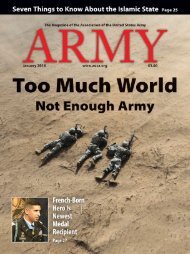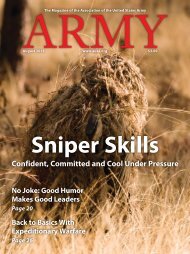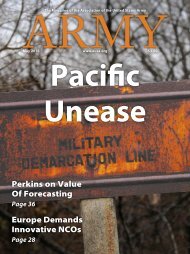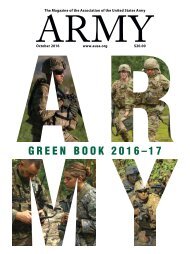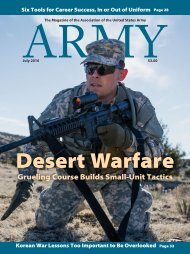Army - Stimulating Simulation
Create successful ePaper yourself
Turn your PDF publications into a flip-book with our unique Google optimized e-Paper software.
Over the next decade, the draft was<br />
used to help fill out the ranks of the armed<br />
forces, but that was not the primary purpose<br />
intended by the 1948 law. The goal<br />
was to build a larger pool of manpower<br />
with military experience that could be<br />
brought back if the U.S. had to fight<br />
World War III with the Soviet Union.<br />
Relatively few draftees fought or died<br />
during the Eisenhower presidency. Indeed,<br />
only a very small proportion of the<br />
eligible population was actually drafted.<br />
Consequently, conscription was generally<br />
tolerated by a public worried about<br />
the red menace behind the Iron Curtain.<br />
A little over 9 million served in the<br />
armed forces during the Vietnam War;<br />
total draftees for that period were under<br />
2 million. This was not a disproportionate<br />
number compared to other modern<br />
wars. Nevertheless, the controversy over<br />
conscription proved unprecedented.<br />
In To Raise an <strong>Army</strong>: The Draft Comes<br />
to Modern America, John Whiteclay<br />
Chambers argues that the draft became a<br />
contentious issue because then-President<br />
Lyndon Johnson and his national security<br />
managers overextended use of it beyond<br />
the consensus established in the world<br />
wars and the early Cold War. As the<br />
Vietnam War became increasingly unpopular,<br />
the draft became the major focus<br />
of dissent. President Richard Nixon<br />
ended the draft in 1973, though the Selective<br />
Service System remains in force.<br />
There are two important points to extract<br />
from the American conscription experience.<br />
First, the argument for it was<br />
based on military necessity: generating<br />
the forces necessary for the government<br />
to fulfill its obligation for the common<br />
defense. For example, Marshall made<br />
the case for Universal Military Training<br />
based on operational requirements. He<br />
assumed the military model employed<br />
for the next world war would be similar<br />
to that of the first two: Armed forces<br />
would be drastically reduced in peacetime,<br />
then rapidly mobilized for war.<br />
Marshall saw Universal Military Training<br />
as an efficient way to speed mobilization<br />
for future conflicts.<br />
Second, conscription works when<br />
there is broad, bipartisan support for it.<br />
The draft riots of 1863 reflected, in part,<br />
growing frustration with President Abraham<br />
Lincoln’s handling of the war, similar<br />
to the backlash that built up against<br />
the Johnson administration in the 1960s.<br />
The argument for the all-volunteer<br />
force laid out by the Gates Commission<br />
in 1970 was that an all-volunteer military,<br />
with a mix of active and reserve component<br />
armed forces, was more efficient as<br />
well as more cost-effective than sustaining<br />
a peacetime draft. The rationale of the<br />
commission remains largely sound. Generally,<br />
the U.S. military does not have a<br />
recruiting and retention problem.<br />
While it is true that the cost of human<br />
capital is spiraling uncomfortably<br />
upward, the draft is not a credible<br />
solution for this problem. Shortservice<br />
conscripts are not going to meet<br />
the high-performance standards required<br />
of today’s military personnel.<br />
Conscription is a manpower model designed<br />
for mass mobilization.<br />
Nor is there anything resembling a<br />
national consensus that would tolerate<br />
national service. In 2001, in the wake of<br />
the horrific terrorist attacks on New<br />
York and Washington, D.C., Rep. Nick<br />
Smith, R-Mich., introduced a bill requiring<br />
Universal Military Training and<br />
Service. It went exactly nowhere.<br />
That’s telling. The American polity is<br />
far more divided now than it was in the<br />
aftermath of 9/11. If Smith’s idea was a<br />
nonstarter then, it is even more of a<br />
nonstarter now.<br />
What makes McChrystal and Mc-<br />
Cain’s idea even worse is that it’s not<br />
based on a practical rationale. They see<br />
national service as a mandatory tool for<br />
teaching citizenship. They believe national<br />
service would serve as a “civic rite<br />
of passage.”<br />
There is certainly a case to be made<br />
that civic virtue is a vital component of a<br />
healthy society. That notion is infused in<br />
the Greco-Roman tradition of civil society.<br />
But by the time of America’s founding,<br />
liberal philosophers had concluded<br />
that the best way to build a virtuous civil<br />
society is to maximize the freedom of the<br />
individual.<br />
The concept of freedom that was established<br />
in the liberal ideas of thinkers<br />
like John Locke and Adam Smith remains<br />
relevant today. Habitual conscription<br />
has no role in sustaining a free society.<br />
That was certainly the conclusion<br />
reached by the Gates Commission. Economist<br />
Milton Friedman, who served on<br />
the commission, argued that rather than<br />
inspire civic virtue, the draftee model inspired<br />
quite the opposite. Friedman saw<br />
as key the distinction between being<br />
forced to serve and volunteering to serve.<br />
McChrystal and McCain argue for<br />
more than just another government program.<br />
They advocate a fundamental reimagining<br />
of the government’s role in<br />
creating a healthy society. That’s a big<br />
step. They are spot-on in recognizing<br />
that national service offers an important<br />
venue for those who wish to live a life of<br />
service. But there are plenty of opportunities<br />
for national service, including paid<br />
and volunteer programs like Teach For<br />
America and the Peace Corps.<br />
Still, there does seem to be a lack of<br />
young people who want to pursue some<br />
form of national service. According to<br />
government statistics, in 2013, the number<br />
of people in government service under<br />
30 years old hit an all-time low—just<br />
7 percent, compared to over 25 percent<br />
in the private sector. “Without a pipeline<br />
of young talent,” Rachel Feintzeig reported<br />
in The Wall Street Journal in June<br />
2014, “the government risks falling behind<br />
in an increasingly digital world.”<br />
Arguably, the decline of youth interest<br />
in national service has more to do with<br />
the nature of it rather than a lack of civic<br />
virtue. Government hiring practices and<br />
human capital management are arcane<br />
compared to those of cutting-edge companies<br />
in the private sector. Mandatory<br />
federal service could well exacerbate the<br />
problem. If government doesn’t have to<br />
compete for people, it will lose incentives<br />
to improve recruiting and retention,<br />
making it more likely that talented youth<br />
will flee federal jobs as soon as they can.<br />
Further, it is far from clear how<br />
mandatory national service would teach<br />
civic virtue. Arguably, the act of voluntarily<br />
participating in federal service is<br />
an act of civic virtue. That suggests the<br />
inculcation of the nature and responsibilities<br />
of citizenship happens mostly<br />
before individuals enter the workforce.<br />
Also, making service mandatory removes<br />
the signature opportunity for<br />
youth to make the individual commitment<br />
to serve others.<br />
In addition, there is the issue of the<br />
appropriateness and effectiveness of giving<br />
government the preponderance of<br />
responsibility for defining and teaching<br />
18 ARMY ■ March 2016


